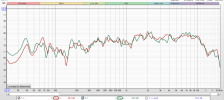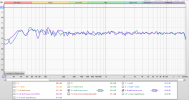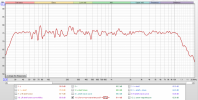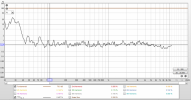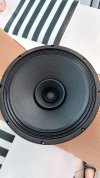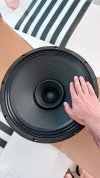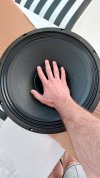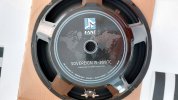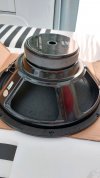One of my friends has built a pair of floorstanding loudspeakers using 12" Fane 12-250TC fullrange drivers. I am posting this on his behalf and with his permission.
Cabinet is sealed with the below parameters:

Made of 19mm baltic birch plywood using internal bracing (unfortunately I do not currently have the pictures of the inside of the cabinet)
The final result looks like this:

The objective measurements will follow below, also with the mdat file attached
Subjectively the sound is typcial to fullrange drivers:
- very 'live sound', you feel like you could talk to the musicians in the room
- extremely holographic presentation, each instrument has its own 3D space
- extremely precise soundstage
- very heavy DSP is needed to flatten the response (all the listenings were done with DSP - don't even try these without it, you will cry )
)
Now the measurements:
FR with zero correction (L/R channels)
1/12 smoothing

FR with full correction

Corrections were done using a combination of 'pre-EQ' low and high shelves followed by parametric EQ-ing using CraveEQ (Transparent Phase Mode) based on REW generated filters and then CurveEQ for further flattening of the response
Also tried Dirac Live but the resulting sound became a bit dull and lifeless compared to the above method
Now when listening to music using the above curves the bass was not there......
After measuring the LR channels combined the reason for that became apparent:

There is a huge cancellation dip between 50 and 100Hz when the two speakers are measured together
Normally we shall not touch this since unwanted ringing might occur if we try to compensate but we had no choice and applied some further filters to correct the summed response which looks like this after correction:

By listening we could not notice excessive ringing, I suspect due to the size of the room (70 sqm)
Bass came to life and the 'order of the world' is restored
Distortion looks OK too in my opinion:

Step response is pretty nice too:

Wavelet diagram:

Overall my friend is extremely happy with the results!
I cannot upload the measurement since it is too big but here is the link to it:
I would encourage anybody to try a big fullrange driver (with adequate DSP) - the listening experience is worth the effort
Cabinet is sealed with the below parameters:
Made of 19mm baltic birch plywood using internal bracing (unfortunately I do not currently have the pictures of the inside of the cabinet)
The final result looks like this:
The objective measurements will follow below, also with the mdat file attached
Subjectively the sound is typcial to fullrange drivers:
- very 'live sound', you feel like you could talk to the musicians in the room
- extremely holographic presentation, each instrument has its own 3D space
- extremely precise soundstage
- very heavy DSP is needed to flatten the response (all the listenings were done with DSP - don't even try these without it, you will cry
Now the measurements:
FR with zero correction (L/R channels)
1/12 smoothing
FR with full correction
Corrections were done using a combination of 'pre-EQ' low and high shelves followed by parametric EQ-ing using CraveEQ (Transparent Phase Mode) based on REW generated filters and then CurveEQ for further flattening of the response
Also tried Dirac Live but the resulting sound became a bit dull and lifeless compared to the above method
Now when listening to music using the above curves the bass was not there......
After measuring the LR channels combined the reason for that became apparent:
There is a huge cancellation dip between 50 and 100Hz when the two speakers are measured together
Normally we shall not touch this since unwanted ringing might occur if we try to compensate but we had no choice and applied some further filters to correct the summed response which looks like this after correction:
By listening we could not notice excessive ringing, I suspect due to the size of the room (70 sqm)
Bass came to life and the 'order of the world' is restored
Distortion looks OK too in my opinion:
Step response is pretty nice too:
Wavelet diagram:
Overall my friend is extremely happy with the results!
I cannot upload the measurement since it is too big but here is the link to it:
I would encourage anybody to try a big fullrange driver (with adequate DSP) - the listening experience is worth the effort

